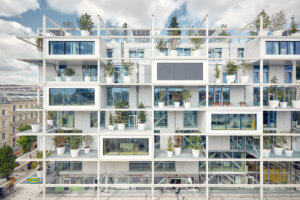Christoph Thun-Hohenstein was the director of the Austrian Cultural Forum in New York before returning to Austria to become the director of the Museum of Applied Arts (MAK), the world’s leading applied arts museum, which features one of the top design collections. The Architect’s Newspaper’s editor-in-chief William Menking spoke with Thun-Hohensteen about the past, present, and future of the institution.
The Architect’s Newspaper: What is the Austrian Museum of Applied Arts/ Contemporary Art (MAK) and how would you describe its mission?
Christoph Thun-Hohenstein: In accordance with a modern understanding of applied arts, the MAK defines itself as a “life museum,” a lively site at the intersection of art and the everyday. The core competence of this outstanding museum with a more than 150-year history lies in the interaction between applied arts and design, architecture, and contemporary art. The last 10 years before I assumed direction of the MAK, there was too much emphasis on contemporary fine art. I tried to reverse that and put the applied arts at the center again. Today the MAK is a world-class museum of applied arts, but it is clearly dedicated to continuing a lively dialogue with contemporary fine art, which we still primarily address as an important impetus to applied arts, though in a different way. The basic assumption for me is that we do not live in times that allow us to carry out business as usual in the museum world (or anywhere else). We live in the midst of a new modernity, which obviously is a digital modernity: The digitalization changes incrementally almost everything in our civilization. People adopt new things and it’s a very important role, especially for applied art museums, to deal with the whole picture of these developments.
Do you believe only an applied arts museum can act in this way?
Yes, because applied arts and especially design deal with almost all things in the world. The digital modernity was primarily driven by design. Think about smartphones and their interface design. It’s our task to have a holistic view, to analyze what is happening together with designers, architects, applied and fine artists, and certainly with research people. We look at what’s going on and act in an interdisciplinary way to come up with orientations, basically about how to shape our digital life. If you’re dealing with a new modernity, it is also inspiring to look back at previous modernities, especially the Viennese modernism. We started to newly analyze design, arts and crafts, developments, and personalities of Viennese modernism, and its current relevance. This in-depth examination also allows us to deal in a new way with important key parts of our collection, among them the Wiener Werkstätte archive, and also make them accessible to the new generations.
The MAK has always had creative and compelling displays of its content by artists. Will this exhibition strategy continue?
Yes doing this is also a kind of precondition of a serious discussion of a new modernity. The exhibition design by artists has meanwhile developed into a tradition and a special MAK feature. It is a result of the intense dialogue between applied art and contemporary art. If you follow our program, you will find many examples for designs of exhibitions and permanent displays by artists, architects, or designers: For example, the Japanese artist Tadashi Kawamata redesigned the MAK Permanent Collection Asia. The concept for the MAK DESIGN LAB, a spectacular complete transformation of the former MAK Study Collection, has been developed by the internationally renowned Austrian design team EOOS. Kawamata’s second installment, which opened this year, is much more radical than the first try and gives you a totally new perspective on Asian objects. Moreover it makes aware that the 2011 exhibition Vienna 1900: Style and Identity [curated by Witt-Dörring and Jill Lloyd] was to a large extent influenced by art in East Asia. What we are trying to distill is that an artistically designed gallery or exhibition can be seen as a total work of art.
Nineteenth century?
Yes. In 1900, there was a strong interest in art from East Asia—in Vienna in general and in other places in Europe. What we’re trying to get out of this is also what we can learn from other cultures today, even how to organize our lives. Japanese culture, for instance, can teach us a lot about how to appreciate objects or rituals of everyday life. In the permanent collection, Vienna 1900, which offers a comprehensive overview of Viennese artistic output in the applied arts from around the turn of the 20th century, it was important for us to show that a new modernity is always about two very distinct approaches: new forms—thinkabout the Vienna Secession and the Wiener Werkstätte—on the one hand and new content and the search for the new human being on the other. In practice, you ideally have a combination of both.
For example the exhibition JOSEF FRANK: Against Design allowed us to illustrate, how Frank, one of the most important Austrian architects and designers of the 20th century, who also did a lot of design later on in Sweden, combined the formal aspects and the content aspects for the art of living. Your home is a kind of central element in your life from which you draw your power and your energy. So it was and is the foremost task for architects and other creative people, to come up with a framework giving utmost quality to people. With Frederick Kiesler, you see completely different angles again: He also focuses on the human being, but first he’s geometric and form-driven and then he kind of gets biomorphic. His work discusses the human being at the interface, let’s say, of nature and technology and there’s so much to learn from that, too.
What other exhibits are you planning for the MAK in the coming months?
In 2017 we will organize the second edition of the biennale, which, initiated by the MAK, was launched in 2015 as the world’s first multidisciplinary biennale with contributions from the fields of art, deign, and architecture. It will again be organized in partnership with the University of Applied Arts Vienna, Kunsthalle Wien, the Architekturzentrum Wien, and the Vienna Business Agency with its creative unit departure, and with support from the AIT Austrian Institute of Technology as a non-university research partner. For the central themes of the next Vienna Biennale—roboting and the future of human work—we need a holistic approach. You can only understand where human work will be found in the future if you analyze all the automation developments including specialized artificial intelligence. We should be aware of the fact that the future of human work also has to be driven by a change in consumption.For instance, more people need to understand that it’s better to buy one, preferably locally produced nice t-shirt designed by the regional fashion designer instead of buying 10 cheap throw-away t-shirts in a large global chain that were produced somewhere and then transported around the world at considerable cost to the environment. You need to convince people to change their consumption attitudes and renounce
For instance, more people need to understand that it’s better to buy one, preferably locally produced nice t-shirt designed by the regional fashion designer instead of buying 10 cheap throw-away t-shirts in a large global chain that were produced somewhere and then transported around the world at considerable cost to the environment. You need to convince people to change their consumption attitudes and renounce those temptations. I go for the one individual t-shirt from a local designer and care about it. What we are trying to do is deal with modernity, get guidance from previous modernities, and inspire people with different parts of our collection, especially when we invite artists and applied artists to deal with the collection. We use that inspiration to come up with impulses, oriented toward the future. We are in the midst of a big role change and you are very much aware of that, not only in architecture and in social terms, but also in design. What we see these days is creative design taking on completely new roles.
What new “roles” are you thinking about here?
Like being moderators of change. It’s my conviction that in order to organize change you should cooperate with designers and artists. Imagine a house with 600 asylum seekers waiting for the asylum decision for a year or more, doing nothing because they are not allowed to work. If you bring in a clever design team devisingprocesses for them, that the higher educated asylum seekers teach the lower educated, that instead of paying for cheap catering, you make it possible for them to cook together, you have the chance to be a moderator of positive change. The same goes for architecture.
By designers you mean architects and industrial designers?
I prefer not to use the term industrial designers. In my perception, it is designers and architects who have to assume new roles and drive the process. The next big task is to bring this new role of architecture and design as a moderator of positive change together with a high quality of aesthetics, of form. This is a process we are in the midst of.
So, to bring a high quality of form together with social?
To bring this social turn of art, architecture, and design together with new aesthetic qualities of art, architecture, and design. While some architects stated that the 2016 Venice Architecture Biennale is the end of architecture, I’m confident that creative architecture will get it right to align strong social content with aesthetic quality. It is one of our tasks as museums to make that happen.










